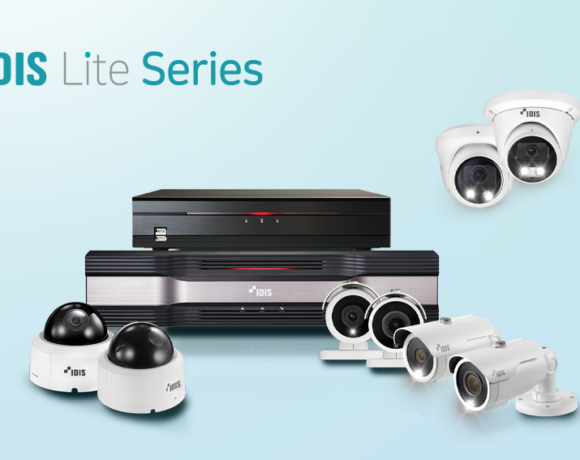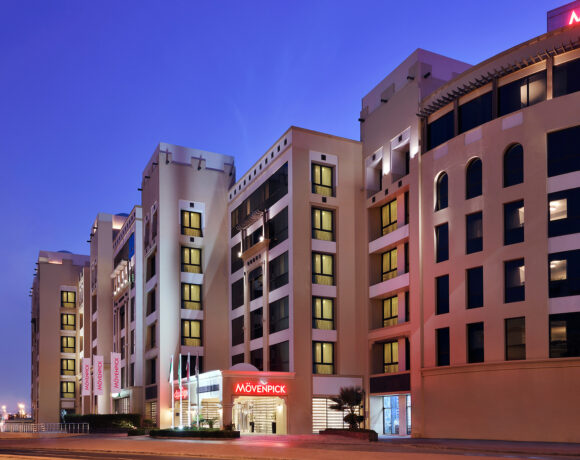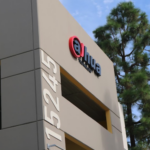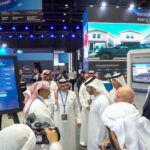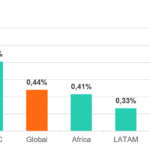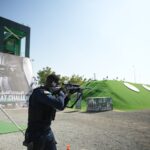Multisensor Cameras Become More Powerful Than Ever

Wide-area monitoring is an important part of video surveillance, especially for end users maintaining large, spacious areas such as airports, parking lots, and warehouses. Yet the challenge has always been the fact these areas need to be covered by multiple cameras, which can be costly and cumbersome to deploy.
Source: asmag.com; E-mail: editorial@asmideast.com
A single-sensor fixed IP camera offers high performance and great resolution, but it has drawbacks, the biggest of which is it covers a narrow field of view, which is a limiting factor when surveilling a wide area. Panoramic cameras overcome this problem by offering 180-, 270- or even 360-degree views of a given area, allowing users to monitor multiple sides all from a single device.
Panoramic and Multi-Directional View
Panoramic views can be enabled either by a fisheye camera or a multisensor camera. A fisheye camera comes with a single fisheye lens, which produces a highly warped view of the scene. This leaves multisensor cameras, which include multiple lenses in a single unit, as an ideal choice. Multisensor cameras can be set up to offer panoramic and multi-directional views. Panoramic multisensor cameras fully cover a wide field of view. For example, a 180-degree camera can cover an entire street scene, and a 270-degree camera mounted on an outside corner of a building can provide total coverage in that space. These cameras are about providing situational awareness across wide areas.
Alternatively, multidirectional views can also be achieved. The sensors can be positioned so they point in multiple directions to offer detailed views from several angles in a particular area. They are ideal for areas such as hallways or road intersections, on outer corners of buildings, and especially in locations such as schools or retail stores.
Higher Image Quality
“Multisensor IP cameras contain two or more stand-alone sensor/lens modules in a single housing. This gives the camera a much higher pixel density for each field of view resulting in significantly higher image quality than what is available from a wide-angle lens paired with a single sensor. With more sensors contained in a single housing, installers, and end-users benefit from reduced installation costs from the single mount and one network cable carrying both power and data,” said Rui Barbosa, Product Manager at i-PRO Americas. “Multisensor cameras also minimize the ports required on a PoE network switch while needing only a single software license for the VMS. These cameras also take up less space and are less intrusive than multiple individual cameras.”
Multisensor cameras offer various benefits. “Using only a single network cable and IP address, multi-sensor cameras take the place of several conventional cameras, allowing users to monitor multiple areas with one device,” said Uri Guterman, Head of Product and Marketing at Hanwha Vision Europe. “They offer significant cost savings for end users as they require far less cable, conduit, and mounting hardware, and involve a single installation process, single power source, single IP address, and single VMS license.”
Applications
The unique features of multisensor cameras make them ideal for any deployment where a high-quality, wide area of coverage is desired. “Multisensor cameras are extremely versatile and are suitable for large indoor and outdoor areas, regardless of the vertical market. For example, at an airport, a multisensor camera can be installed indoors to keep the terminals safe and secure by effectively monitoring the flow of traffic in two directions or outdoors to monitor the airfield. At a school, it can be installed indoors to protect hallway intersections or outdoors to safeguard the parking lot. For cities, the multisensor camera can provide optimal coverage of major road intersections,” said Hamish Dobson, Corporate VP for Enterprise Physical Security at Motorola Solutions.
Vertical markets that can benefit from multisensor cameras include retail, cities, transportation, government, education, and hospitals. However, these cameras are used for non-security purposes as well, helping end users achieve further business intelligence. Beyond security, multi-sensor cameras have been proven to decrease shrinkage, resolve staff and customer disputes, provide forensic documentation to build cases and prevent fraudulent claims, and improve traffic flows in traffic monitoring, amongst many other applications.
Retail, in particular, can benefit. Multisensor cameras can be embedded with various analytics software to help organizations better deal with various aspects of their business. For example, retailers could use the 180-360 degree vision/view of the cameras to see how customers move around a store, where bottlenecks appear, and where cash desks are busy, so they can optimize the layout of the shop floor for greater operational efficiency and an improved customer experience
Empowered with Artificial Intelligence
More and more, IP cameras are empowered by AI-enabled video analytics, which adds more intelligence to the camera. Multisensor cameras are not exempt from this trend.
“Adding AI to a multisensor camera means a user does not have to constantly monitor for events, as it automatically alerts operators to specifically configured events, for example, vehicles entering an area and people loitering. They also provide accurate object classification, object tracking, rapid event search, and the possibility of edge-based business intelligence. Adding AI also reduces false alarms,” Guterman said.
“The addition of AI to a multisensor camera can turn video security systems from a reactive to a proactive solution. Security operators monitoring site cameras for long periods of time can experience attention fatigue and stress, which may result in events being missed. Multisensor cameras that come equipped with AI-powered video analytics can help detect and alert operators of potential events that may go unnoticed and need their attention, such as a person loitering or a vehicle trespassing, and help expedite response times and investigations,” Dobson said.
According to Barbosa, because AI-based analytics can be installed on each sensor, it allows much more customization with regard to analytics being used in each direction. “An installer might have one direction being used to count people coming through a door, while another direction might notify how many people are in a checkout line. A third direction could be monitoring unauthorized access to a restricted area. The possibilities are endless, and that fact that you can do all of this from a single vantage point is truly powerful,” he said.
Types of AI Used
At the minimum, AI used in multisensor cameras allows for object detection and classification. This enables the system to detect objects such as people, vehicles, number plates, and others.
Then, there are more advanced solutions that can further analyze details in the scene. “More advanced models classify attributes such as age, gender, color and type of clothing, accessories (such as a hat, face mask, glasses, bag) as well as vehicle type, make color and even model,” said Uri Guterman, Head of Product and Marketing at Hanwha Vision Europe.
Advanced AI analytics are able to run on these cameras thanks to more powerful hardware, especially the system-on-chip, that has enough computing power to execute complex algorithms.
“When processing on the edge, it’s important to have a powerful and flexible SoC that can support multiple analytics processes in parallel while consuming very little power,” said Rui Barbosa, Product Manager at i-PRO Americas, who used his company’s offerings as an example. “Because the field of AI is changing so rapidly, i-PRO has chosen the powerful Ambarella AI SoC which is also advancing the technology behind autonomous vehicles, IoT, and robotics.”
Indeed, AI and multisensor cameras form an ideal solution for different types of users, who can be more situationally aware and perform their tasks with more effectiveness. “These capabilities can provide greater insight into what is happening at the site, allowing security operators to make better-informed decisions and respond to events. Multisensor cameras have no barriers to using AI analytics compared to standard cameras and the value they bring depends on the use case, the installation, and the field of view,” said Hamish Dobson, Corporate VP for Enterprise Physical Security at Motorola Solutions.
Selection Process
There are certain key considerations to be made when selecting an AI multisensor camera. First, it must be noted that in order for the AI to work effectively, the image quality must be good. Therefore, the user should look at the various specs to make sure the camera can produce a good-quality image.
“Total resolution and frame rates are important specifications to consider. Multisensor cameras are intended to be deployed in large areas where people, vehicles, and important details might be far away from the camera. The higher the camera’s resolution and frame rates, the easier it will be for it to capture the level of detail required, giving a clearer picture of what’s happening at the site,” Dobson said.
“IR illumination is another important feature to consider, particularly for monitoring outdoor areas where dusk or nighttime can make it difficult to see. The option to have IR illumination on multisensor cameras allows security operators to see the site clearly even when it is poorly lit or completely dark,” he added.
Being able to work with the right VMS is another key factor to consider. “It’s crucial that the AI camera be paired with a VMS system that supports all the metadata that the camera is generating. If the VMS can’t support all the data from the camera, then the system is limited from the start. This is why i-PRO created the Active Guard plugin that can be installed in popular VMSs such as Genetec and Milestone allowing them to display and work with every attribute the camera can detect,” Barbosa said.
Optimizing Installation
How to install a multisensor AI camera is also critical if optimal results are desired. In this regard, various considerations also need to be made, for example, the area to be monitored, the field of view, and the ideal height for installation.
“For the best AI-based analytic performance, it’s important to not mount the camera too high. A well-placed multisensor camera can easily replace three or four standalone cameras at the corner of a building or a hallway intersection. For hallways, it’s also important to choose a camera that can optimize the aspect ratio to display more hall than a wall. Depending on the distance to be covered, it may be useful to specify 4K sensors to ensure the pixel density is high enough to discern faces and other distinguishing features,” Barbosa said.
“Multisensor cameras bring a lot of flexibility and can be installed in many different ways. For example, 180-degree multisensor cameras are typically used for wall-to-wall coverage, whereas 270-degree multisensor cameras are most suitable to cover building corners with no blind spots. On the other hand, 360-degree multisensor cameras offer excellent coverage when installed in the middle of intersections and wide areas such as parking lots,” Dobson said.
It’s good to note that there are certain online tools that can help optimize installation. “Online tools such as the Wisenet Toolbox Plus allow users to make simple field-of-view calculations and select the right capabilities, lens options, and accessories for their specific installation. System integrators can easily search, filter and compare product specifications side-by-side and then compile a list of the products required for a specific project. This, in turn, generates a report on the estimated bandwidth and storage requirements for the project,” Guterman said.


